|
|
A Day Tour on the Montju´c
While I Summarized nearly all sides of Barcelona after categories like museums, churches or parks, I will describe on this following page an unforgettable, very multifaceted day tour to the local mountain of the city, the Montju´c. I am aware of the fact that some fast tourists do this tour on half a day. But during my tour, we do not only loo down to the city Barcelona but also to different buildings, museums, the Olympic Complex, the Spanish village and we finalise the tour with one of the most spectacular events that are available in Barcelona during the summer time between Thursday and Sunday: the water games underneath the Palau Nacional. Cable Way Trip to the Montju´cWe start our tour at the outer tip of Barceloneta. From the Platja de San Sebastiá or from Platja de Barceloneta, we see at the lowest tip of the headland of Barceloneta a strange tower that rather reminds on a headgear of a mine than on a cableway station. On the tower there is a panorama restaurant; but we are interested in the cableway that leads from the top over to the Montju´c. It is "only" a cableway trip over to the local mountain of the city but only the trip is already so impressive that many tourists only take the cableway to the Montju´c in order to get back to Barceloneta after having shot a couple of pictures. The trip is spectacular, a one-way ticket costs 7,50 €. From the gondola, one has some great views to Barcelona, and one is very close to everything! 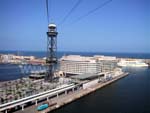
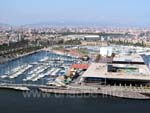
One has probably already seen the city Barcelona from one or two view points. But from the Montju´c-cableway, one looks straight down to the harbour moles. Actually, one should do this trip at the very beginning of the journey, so that one gets an overview what will go on by being on foot... Those who do not get an optimal seat at the window in the gondola do not need to worry as the gondola does an intermediate stop on its way to the Montju´c on a view tower on the Mol de Barcelona. Here, one can get out in order to enjoy an all-around The gondola waits for some minutes but one can also wait for the next gondola. After the second part of the gondola trip one gets to the Montju´c station, where the next large observation deck is waiting. From here, Barcelona is at one's feet. By walking approximately 100 metres further, one can really see for the first time into the industrial harbour of Barcelona. The Montju´cAfter the fascinating cableway trip to the Montju´c, we are still far away form being on the top of the mountain; Now, the roundtrip really starts! On the peak of the mountain there is a fortification that in former times served the besiegers of Barcelona to keep in check the rebelling population. In the second half of the 20th century, under the governance of the military general Franco, the fortification even served as a prision. Today, the fortification is located in the military museum. 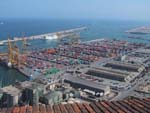
One surely does not go to the local mountain of the city in order to visit the military museum. A big number of cannons are also visible in the museum complex. But from there above, there is an all-round panorama view that is unique. On one hand, one has the big city at the front, on the other hand, one can look down to the busy industrial harbour. 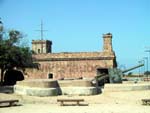
But how does one get up to the fortification after having arrived with the gondola? There is a quite boring footway up to the approximately 200 m heighted peak. But it is much nicer to take another small gondola that takes one up. Before that, one walks alongside the Avinguda de Miramar (the main road on the Montju´c) for approximately 500 m. For approximately 3 €, one gets to the peak with the slow gondola for four persons. This gondola trip is romantic, as one sits in the small gondola like in a nutshell and can look to wonderful gardens underneath. But one should not take this gondola for returning back but better walk. At the upper side of the middle station of the Teleféric, a little path turns, that leads one through some beautiful gardens to the valley station of the gondola. The Olympic Complex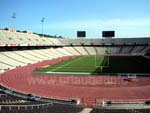
The next highlight of our day tour was the olympic complex from the year 1992. Once arrived down at the cable way, we have to walk further 500 m on foot before we find the olympic complex from the year 1992 at the left. On this way, we find at the right the Fundació de Miró, founded by the artist Miró in the year 1975. The foundation exhibits creations of all life phases of the artist. It is a matter of taste if one likes the avantgarde museum as also the creations of Miró. The 25th olympic summer games were opened on the 25th July 1992. Most of the competitions took place on the complex of the Montju´c. The olympic complex is free accessible; Right at the road Avinguda de Miramar, that from then is named the Avinguda de l'Estadi, the Estadi Olimpic de Montju´c is located. One can access the stadium on a small platform and have a view into the inner round. It is a matter of opinion if one should see the further olympic facilities. Some people who followed the Olympic Games 1992 on TV might have a look at the sports facilities in reality. The National Palace (Palau Nacional)From the entrance of the olympic stadium there are only 100 m to the National Palace - a further highlight of our day tour. The Palau Nacional is a gorgeous building with small towers and cupolas; it reminds on a little castle. The Palau Nacional was built in Barcelona for the second world Exhibition in the year 1929. After the world exhibition, the Museum for Catalan Arts moved into the palace. 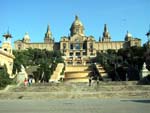
But a visit to this museum is not in our day schedule, the time is getting short and there is still a lot to see. Only the outer complexes of the National Palace are already very impressive, specially by walking alongside the front of the palace. From here, one has a majestic view over several cascades down up to the Plaša de Espanya. It is almost unbelievable that here, a King never lived. Even if the time is short, one cannot avoid to sit on the stairs of the Palace and enjoy the gorgeous view down to the Plaša de Espanya. It is also good to have a rest of some minutes as from now, the legs will be strained again. But later on when it got dark we will return to this place. Poble Espanyol - the Spanish VillageFrom the Palau Nacional, we walk down the Montju´c further to the west until we come across to one of the most popular sightseeings of the big city: it is the Poble Espanyol (translated: Spanish Village), that was opened on the occasion of the second world exhibition in the year 1929; What kind of village is this, for which one has to pay 7 € entrance fee? 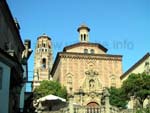
In the Poble Espanyol, one finds the whole country of Spain in small replica. The famous buildings from all areas of Spain were copied true to the original. In the centre, there is a main plaza (Plaša Major) that is surrounded by houses and little streets. At the entrance, one gets a "city map", so that one can orientate in the little village. The individual small houses are all labeled. Those who already have visited other Spanisch landscapes and cities will recognize some of these buildings. 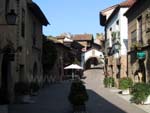
The village is indeed opened until late at night for the visitors, but one should in any case visit the village before 06.00 p.m., as at this time the shops close. As it should be for a small village, in the lower floors of the houses, one finds some little shops. One can watch numerous craftsman during their traditional work ans also buy their artworks and products. From leatherware to pottery up to textiles, practically everything is available. In the Poble Espanyol there are also numerous coffee bars and restaurants that partly are very good. On the main plaza of the city there are also numerous open air concerts. I was so lucky to be able to listen to a kind of caribean-jazz-band during their practices. What a bargain to experience such a concert "by the way" during the visit of the village! Water Games in front of the National Palace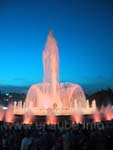
So far, during our huge day tour, we had enjoyed some dream panorama views, saw some beautiful parks and gardens, visited the olympic facilities from the year 1992, gazed at a gorgeous National Palace and did a little round tour through Spain in the Spanish village. The legs already ache, the perceptive capacity is exhausted; but we finalize the day with an absolute highlight that is not only the highlight of the day but one of the highlights of the whole journey to Barcelona and a highlight that I never saw mentioned in any german travel guide: 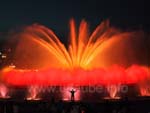
We return to the Palau Nacional and/or to the Plaša de Espanya or the stairs in between. Here, a spectacle is offered to us that is rarely seen in one's life anywhere else in the world. From May to September, there is from 09:30 p.m. every half an hour up to midnight some Watergames like there are no other in the world; A huge fontaine sputters water at a height of more than 10 m. During this show, classic music is played and a play of colours that one will never forget. 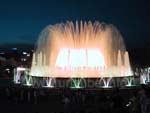
All kinds of fountains alternate in the most different colours, from deep red up to the brightest white. Sometimes, the jets spray the water to the highest, sometimes, a fog is foamed that seems to be taken from the future. One round always takes approximately 15 minutes; the remaining 15 minutes up to the next show are used by streets performers and artists to entertain the audience. Apropos audience: of course, one does not enjoy this show alone; thousands of viewers come day by day to the places in front of the National Palace in order to experience something unforgettable in Barcelona. 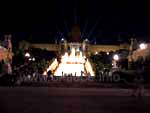
Of course, the first two shows are overflowed by the tourists. But from half past ten, one can really enjoy the water games. It is most imposing to sit on the cascades, the stairs upside the fountain and simply let the show happen. Of course, at night, the Mational Palace is wonderfully illuminated. And at the other side, one can admire the brightly illuminated church Sagrat Cor on the Tibidabo, as in every night. Here, our day tour to the Montju´c also ends. Those who read up to here will also understand why I have the firm opinion that Barcelona cannot be visited in one single day but several days or even weeks are needed. But a day like this will be not forgotten in a lifetime. 
Copyright: Patrick Wagner, www.tourist-guide.biz |
||